2024 Outstanding Scholarship
The proposition for this Outstanding Scholarship Painting submission was to “use self reflection to explore the human condition.” As a contemplative project using a restricted scope of self and personal surroundings, specifically home, this submission provides in-depth analysis combining literary and artistic references to create technically fluent and
confident paintings. Early in the enquiry, the candidate identified a range of painterly approaches they wished to integrate into their practice, alongside particular pictorial and thematic strategies.
The development of original and authentic source imagery via staged photography was supported by a range of established artist practices, which have been carefully chosen to support the theme, scope, and context of the study.
Choices around colour palette, development of surface, lighting effects, and point of view are supported by close analysis of artist reference, which include James Ensor, Caspar David Friedrich, Michael Chevel, and Jacqueline Fahey.
For the candidate, this presented an opportunity to locate themselves within a range of practices to construct a sense of their own narrative. Planning and careful development of composition is evident in this submission as the candidate crafts their paintings. Narrative approaches and literary allusions abound as the candidate confronts the vicissitudes of being. Established visual techniques of Rückenfigur, festaiolo, and mise-en-abyme are thoughtfully employed in image-making, while shifts of scale, pose, and gaze allow the viewer to gain insight into the central character. The
candidate describes this as exposing the “raw vulnerability” of themself. By searching for symbolism in the mundane and commonplace, and literal reference to the self, this enquiry creates a particular sense of introspection. The narrative shifts between points of view, looking at and looking with the artist as multiple representations of self, environment, and the passage of time swing between the whimsical, imaginative, and mundane in an increasingly
dreamlike state.
A strong technical exploration into oil painting processes has taken place and is supported by the workbook. Colour and surface decisions are underpinned by various mark-making strategies dealing with paint consistency to achieve a particular outcome. This has been expertly employed where the candidate skillfully combines gestural brush marks and impasto with blending, glazing, and overpainting to vary the pace in and between phases of work. Focal points are carefully controlled within individual artworks where brush shape and size, weight, and speed of paint application have been carefully considered. Textured and activated surfaces act as a counterpoint to more detailed passages that allow the eye to travel, and rest, in paintings. The generation of images is strongly established in a process of thinking, trialling, and construction where sketching, photography, and digital collage are employed to create meaning within and between works.
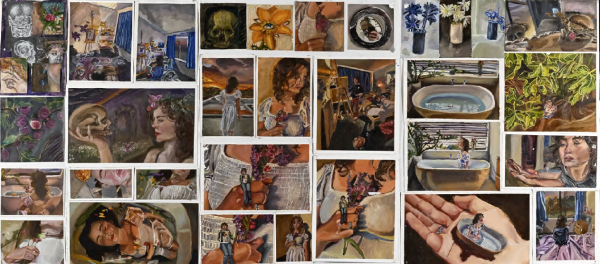
Download 2024 Outstanding Scholarship Painting workbook [PDF, 2.7 MB]
On this page
2024 Scholarship
This Painting Scholarship submission demonstrates a sophisticated, personal inquiry exploring bi-cultural and multi-cultural concerns. The candidate positions themself at the centre of the study, investigating commonalities between cultures, symbolism, and imagery in a post-colonial Aotearoa New Zealand context. There is a high level of engagement and understanding in the workbook and folio, where the candidate develops well-considered
strategies to convey their ideas.
The candidate researches and develops a range of symbols and motifs in their drive to eventually create works that will communicate cross-cultural harmony. Intentional references to damage are made in the initial stages of the project in the form of a smashed mirror and broken pounamu, deliberately employed to allude to Aotearoa New Zealand’s colonial past. Decorative elements of rococo carving and pearls, employed to suggest an imposed European aesthetic, are juxtaposed with native birdlife, landforms, tukutuku, and kōwhaiwhai, which are referenced to represent the natural beauty and established cultural narratives within Aotearoa New Zealand. Panel 1 culminates in a large work that combines Renaissance religious symbolism with distinctly Māori iconography. In this work, a young wahine is depicted to personify beauty in a cross-cultural context. She is surrounded by sumptuous green fabric and blue kōwhaiwhai with an “immaculate heart”, a reference to biblical Mary showing love and compassion for humankind; an icon for a harmonious future.
Subtle and purposeful juxtapositions are made throughout the submission, which are reinforced with solid research and exploration within the workbook. Artist models, movements, and techniques are combined with research where the candidate has visited sites of personal significance. References to Māori and other cultural motifs are employed
with sensitivity as the candidate explores ways to communicate a contemporary multicultural Aotearoa New Zealand. Kōwhaiwhai motifs, including mangōpare and koiri, are combined with topographic contour lines to suggest the strength and nurturing of the whenua, and Japanese kintsugi repairs the distinctly British signifiers of teapot and cup.
Varying approaches to media, processes, and format are explored by the candidate and are used purposefully where the form of the artwork matches its meaning. Collage works are explored to capitalise on tearing, cutting, and sticking together, both as a technique and as a metaphor within the visual language. Images are thoughtfully constructed and produced with high technical facility, aligning subject and atmosphere to communicate ideas with clarity. Motifs are advanced, repeated, and re-framed at each stage of the process to create passages of movement and stillness.
In the early stages of the proposition, the candidate states clearly their intent in key statements: “Personal point of view as a young female Pakeha” ; “Analyse the conflict in New Zealand’s history” to explore the “harmony that could exist” and to “explore New Zealand as a multi-cultural society and...my place as a European New Zealander in that society”. As such, this submission is an authentic and refined personal investigation. It is thoughtful and analytical, and seeks to communicate issues of importance.
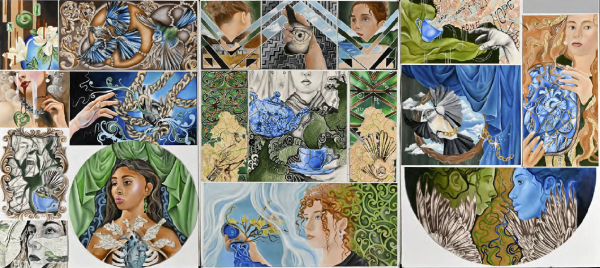
2023 Outstanding Scholarship
The premise of this Outstanding Scholarship Painting submission was to depict faʻasamoa, faʻasinomaga (Samoan way of life, Samoan identity) and share the “beauty and complexity” of everyday practices and traditions through the candidate’s diaspora lens. As a personal project about identity (they identify as a queer, New Zealand-born Samoan), the candidate is deeply invested and engaged in the proposition, which they negotiate through solid, in-depth research and integration of their thinking into technically expert paintings. From the outset, the folio works interweave complex pictorial strategies that provide navigation for the storytelling and signifiers utilised.
The artwork is beautifully rendered and powerful in its visualisation. Intentionality is a vital factor in the conception of the paintings and analysis of motif and compositional structure. The candidate utilises symbolism to situate their culture as the subject matter and vehicle; architectural references such as the shape of the fale tele enacting the sky (heavenly / biblical association) or the use of tatau to communicate the story of their grandparents’ immigration to Aotearoa from Samoa. All visual aspects are considered equally: line, tone, pattern, figurative, perspective, paint stroke, and colour palette.
Artistic reference is excellent; the range of practices from senior artists to younger generation practitioners serves to provide a community of voices and an apt neighbourhood of contextual references. The candidate investigates Christian art, historical representations of sacred subject matter, traditional processes of tatau, lalaga, siapo, fale, siva, and images of ancestors and family to create imagery that speaks to Samoan culture. For the candidate, this approach to traditional art forms and histories addresses the influence of colonial forces in Samoa and their own “feelings of inadequacy and disconnection, being culturally assimilated, being disconnected from the church, and being queer”.
The workbook documents a thoughtful, well-researched, and critically focused journey. At every step, they are self-reflexive about previous steps taken and consider how learnings can be utilised to make the following passage of work. They combine the personal with collective and inherited knowledge; the workbook intelligently frames the candidate’s line of questioning. Throughout the enquiry, they discuss the selection, relevance, cultural significance, and meaning of symbols in both their own artwork and historical contexts. The methodology is thorough and holds close to the candidate’s intent to make work exploring their familial history through symbology and pattern.
The folio layout is structured incredibly well. There is a symmetry and rhythm to the linear and patterned compositions reinforced by the movements between the individual artworks of the stained-glass works and the images of Samoan people / family (ancestors and themselves) performing and making. This is an important aspect in the communication of faʻasamoa and faʻasinomaga and the cultural value placed on performance and crafting, intergenerational knowledge and making by hand. The folio paintings skilfully communicate a celebratory honouring of Samoan culture and the candidate’s story.
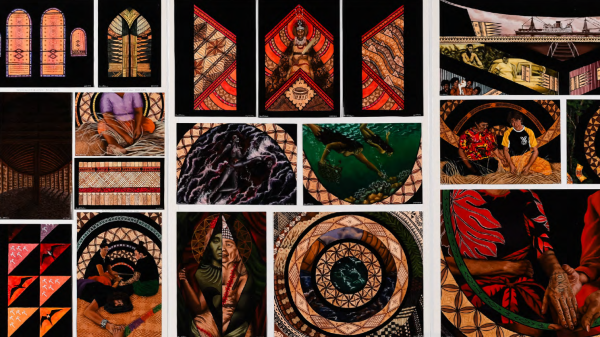
2023 Scholarship
This Painting Scholarship submission presented a sophisticated self-portrait and personally relevant enquiry about gender fluidity. A high level of engagement and ownership is present in the folio and workbook. Holistically, these two sites of evidence combine to engage in an intensive exploration of self and identity.
The candidate employs compositions and figurative elements from other artists’ works, such as Frida Kahlo, rendering their own image in Kahlo's androgynous persona in Self-Portrait with Cropped Hair, 1940. This symbolic gesture affirms their own story and representation of “transgenderism”. In the portrait, raw handwritten words of perception hover above them as they hold a pair of scissors (also commenting in the workbook that “Mum kept my hair”), whereas Kahlo’s hair lies strewn on the ground. This work is an influential piece; it is a signifier of the beginning of their “transition and freedom from binary perception”, characterising this moment as an emotive expression of their resentment of such perceptions.
Artistic references are carefully selected and well-utilised and make sense of their chosen strategies and devices used to create the controlled and complex folio works. They also look to Rita Angus’s paintings as an example of masculine-styled portraiture; Guido Reni’s Saint Sebastian, created in 1620–1639, to convey ideas of transgender persecution; and Jacques-Louis David’s The Death of Marat, 1793, to speak of their personal loss and betrayal. The adaptation of these artists’ work as a kind of metaphoric symbology is powerful and communicates the determination and strength of the candidate’s willingness to share their stories.
Every media process, motif, and stylistic characteristic is a representative part of the candidate’s identity and lived reality, such as the collagic, fractured compositions to confuse the portrait structure, the inclusion of top surgery scars on a traditional figurative pose and the birth certificate held in their hand in the bath. Colour is a crucial symbolic and representational element utilised to embody their frustration and pain, thus introducing olive green into the palette to give the works a murky and ill-at-ease edge.
The candidate understands the fluidity of paint media to represent gender fluidity (a symbol of their fluid state). They employ methods such as marbling that rely on unpredictability and chance patterning to create abstract compositions, blocked areas, and motifs in paintings. The direct nature of the painting compositions, poses, perspective, and the rawness of media is well-handled; we are left with no doubt about the candidate’s feelings and state (body dysphoria, dissociation). The blank stare that persists throughout the works assumes an immediate challenge to the viewer; they are asking for respect and want their art to provide comfort for their community, stating in the workbook, “I want it to impact your thoughts on queer identity and the boxes constraining it within your mind.” This painting submission is an original and self-determined Scholarship exploration of trans identity and experience that is technically refined and mature in its synthesis and perspective.
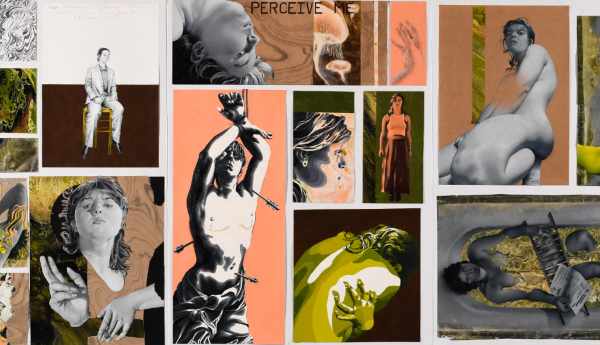
2022 Outstanding Scholarship
This Outstanding Scholarship submission is a conceptual investigation into the theme "Distorted Rabbit," exploring the importance of identity with a sub-theme of Dadaism. The project is grounded in practice within an abstract paradigm, evidenced in statements such as "... enjoy the distorted rabbit struggling and worrying about the meaning of its existence." The 'with abandon' approach to making is evident throughout.
Individuality, as a concept and framework for the practice, holds significant importance to the candidate (coming from Japan), where they experienced an education that they felt ignored individuality. In their proposal, they express their interest in exploring their true self and view the folio/enquiry as an opportunity to delve deeper into their "aesthetic sense, thoughts, and feelings in the unconscious." Distortion serves as the key conceptual and processual tool used to analyse the candidate's thought processes and logic.
The strength of the submission lies in the thorough investigation into materiality and process, along with the experimental use of surfaces and a range of media. The materials employed include rice paper, tracing paper, gauze, building papers, thread, ripped canvas, wire, tissue paper, and cardboard. Various painting approaches, such as impasto, transparency, layering, and spray paint, complement the choice of materials and media. The candidate also prepares different grounds on a variety of surfaces using transparent color, thick layers, etc., before introducing structural elements.
Risk-taking and finding solutions through discovery form the primary mode employed to develop the body of practice. Each work and study is carefully considered in terms of the placement of forms within coherent structures. The technical aspects, such as the woven areas and layering of materials and media on the final works, are beautifully crafted. Intuitive, robust media manipulation, and conceptual clarity are utilised to construct the image. Notably, the works transcend mere study to become artworks. The strength of the portfolio lies in the application and construction of layering as a method; multiple layering devices are used in different ways to explore collage and find solutions. Composition is the fundamental building block of the success of the body of work.
The workbook/visual diary is intelligent and insightful, exemplifying the depth of the investigation through description and discussion. The 'live' analysis of the processes involved and the explanations of 'why/what/how' decisions were made are particularly notable. It also includes documentation of works (not in the folio), locating them within the conceptualisation process (e.g., Foam series), and demonstrating the relevance of experimental phases that have impacted the broader project.
The contextual review includes references to artistic practice and anime, ranging from modernist painters to contemporary art. Each reference has a clear rationale and point of interest. Dada, as a critical movement and methodological approach, was particularly influential in the candidate's thinking. They fluidly moved between their observations of artists' practices and their own work, always returning to drawing and experimentation with the knowledge gained.
Looking at the work, there is a real sense that the candidate operates without limitations; they make with an adept hand and confidence (‘just to see’). They talk about their hands moving unconsciously, letting the media and process 'do the work'.
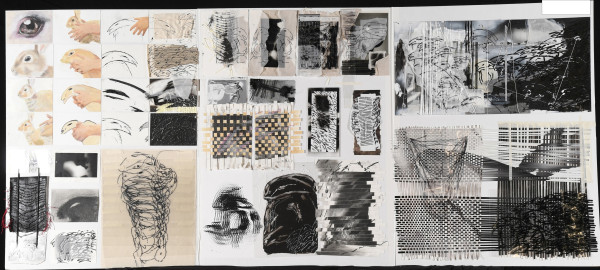
Download 2022 Outstanding Scholarship Painting workbook pages [PDF, 30 MB]
2022 Scholarship
This scholarship submission is based on personal experience and is dedicated to the candidate’s great, great grandfather, who fought in the 28th Māori Battalion in World War I. The proposal is focused, inquiring, thoughtful, and embraces the power of painting to honor their tipuna tāne. The candidate pursues an investigative journey of personal historical significance, working with whakapapa, whānau, and tūrangawaewae concepts. The proposition exudes authenticity through the personal perspective and use of media to communicate and honor the subject studied in each artwork.
In the workbook, the candidate begins with their pepeha and identifies the desire to explore their culture, identity, and whakapapa, recognising that it is because of their tīpuna the candidate is “interconnected to the sacrifices made by my ancestors for me to exist today.” The analysis of work as it develops is well-grounded, enabling the candidate to find their footing and recognise strengths and weaknesses to build on. They found a style appropriate to the conceptual, contextual subject matter and worked with it through thoughtful layering and integration of text.
The student presence is evident throughout the investigation in the personal source material linked to historical and cultural contexts and the analysis of composition, meaning, and intent. They examine Te Ao Māori, their tīpuna, and concepts of past/present/future through purposeful use of symbolism and selection of images (photographs). Painting conventions of portrait and compositional devices are used to explore the passage of time, to piece together fragments, stories, records of events, and histories discovered. For example, they use black and white and pointillism to reference historical photography, and color for recent photos and interpretations.
The painting practice is underpinned by strong drawing and media skills. Various pictorial strategies support these approaches: grid, layering, overlay, silhouette, text, impasto, glaze, painterly mark-making, and color symbolism. The work weaves personal/social/historical narratives about Māori warriors/soldiers and the Māori Battalion through well-planned technical and compositional arrangements – symbolically and metaphorically. There is warmth in the research and joy in making this work. Central to the works are people/family/place/time. As a framework, these elements move the body of work beyond the folio and embed a sense of power and dynamism.
This submission evidences a close engagement with and honoring of whānau. The care and attention paid to every artwork on the folio, and analysed in the workbook, is a testament to the whanaungatanga, the love and connectivity of the candidate to his tīpuna and whānau.
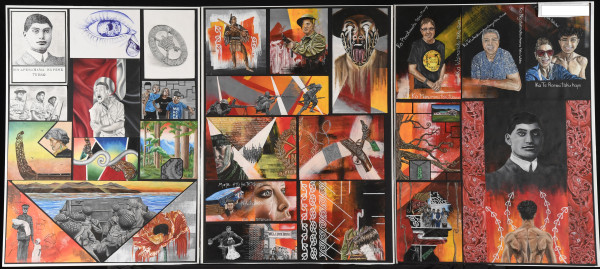
Download 2022 Scholarship Painting workbook pages [PDF, 33 MB]

